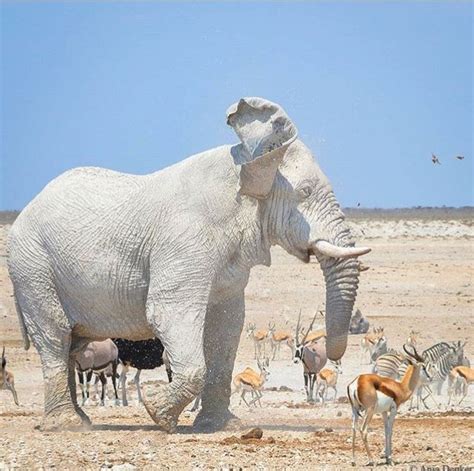
A rare, pale-skinned elephant, nicknamed the “Ghost Elephant” due to its unusual coloration, has been spotted in Botswana’s Okavango Delta for the first time in several years, captivating wildlife enthusiasts and conservationists alike. The elephant’s unique appearance, likely a result of a genetic condition called leucism, makes it a striking and infrequent sight in the region’s elephant populations.
The sighting, recently confirmed by wildlife photographers and local guides operating in the area, has reignited interest in the elephant’s well-being and conservation status. While not an albino, the “Ghost Elephant’s” light pigmentation poses unique challenges, particularly in terms of sun exposure and potential vulnerability to predators.
A Rare Sighting Revives Conservation Concerns
The reappearance of the “Ghost Elephant” has provided a significant boost to ongoing conservation efforts in the Okavango Delta, a UNESCO World Heritage site renowned for its rich biodiversity and large elephant populations. This unusual elephant serves as a compelling symbol for the need to protect and understand the genetic diversity within these populations.
“The Okavango Delta is one of the best places to see elephants in southern Africa,” according to a local guide who requested anonymity to protect the elephant from potential poachers. “To see one so unique is truly special, and highlights the importance of our conservation work.”
While specific details about the elephant’s age, sex, and current health are still being gathered, its presence has already generated considerable excitement among researchers studying elephant behavior and genetics. The elephant’s distinct appearance allows for easier identification and tracking, potentially providing valuable insights into its movement patterns, social interactions, and overall survival.
Leucism vs. Albinism: Understanding the Difference
The term “Ghost Elephant” stems from the animal’s pale, almost ethereal appearance, a result of leucism. Leucism is a genetic condition characterized by a partial loss of pigmentation, causing white or pale coloration in the skin, hair, feathers, or scales, but not in the eyes. This is a crucial distinction from albinism, which is a complete absence of melanin, the pigment responsible for color, leading to white skin and hair, and often pink or red eyes.
Animals with leucism often have patches of normal coloration alongside areas of reduced pigmentation. In the case of the “Ghost Elephant,” its skin is significantly lighter than that of other African elephants (Loxodonta africana), but it retains some pigmentation, preventing it from being classified as an albino.
The causes of leucism are varied and can include genetic mutations that affect the production or distribution of pigment cells. While not inherently harmful, leucism can increase an animal’s vulnerability to predators, as their camouflage is compromised. They can also be more susceptible to sunburn and skin damage due to the lack of protective pigmentation.
The Okavango Delta: A Sanctuary for Elephants
The Okavango Delta, a vast inland river system in northern Botswana, is a vital refuge for African elephants. The delta’s unique ecosystem, characterized by seasonal flooding and a network of waterways, provides abundant water and food resources, supporting one of the largest elephant populations in Africa.
However, even within this sanctuary, elephants face numerous threats, including poaching, habitat loss, and human-wildlife conflict. The “Ghost Elephant’s” reappearance underscores the ongoing need for effective conservation strategies to protect these magnificent creatures and the delicate ecosystem they inhabit.
Conservation organizations working in the Okavango Delta employ a range of methods to protect elephants, including anti-poaching patrols, community engagement programs, and habitat management initiatives. By working closely with local communities and governments, these organizations strive to create a sustainable future for elephants and other wildlife in the region.
Implications for Elephant Conservation
The sighting of the “Ghost Elephant” raises several important considerations for elephant conservation. Firstly, it highlights the importance of maintaining genetic diversity within elephant populations. Leucism, while rare, is a naturally occurring genetic variation, and its presence underscores the need to protect the full spectrum of genetic diversity.
Secondly, the “Ghost Elephant’s” vulnerability to environmental factors emphasizes the importance of mitigating threats such as poaching and habitat loss. By reducing these pressures, conservationists can increase the chances of survival for all elephants, including those with unique genetic traits.
Thirdly, the “Ghost Elephant’s” popularity serves as a reminder of the power of wildlife tourism in supporting conservation efforts. By attracting visitors and generating revenue, wildlife tourism can provide economic incentives for protecting elephants and their habitats.
The Okavango Delta benefits from a robust tourism industry, with numerous lodges and safari operators offering opportunities to see elephants and other wildlife in their natural environment. Sustainable tourism practices, such as responsible waste management and minimizing disturbance to wildlife, are essential for ensuring that tourism benefits both the environment and local communities.
Tracking and Monitoring the “Ghost Elephant”
Conservationists and researchers are now focusing on tracking and monitoring the “Ghost Elephant” to gain a better understanding of its behavior, health, and survival. This may involve using GPS collars to track its movements, collecting samples for genetic analysis, and conducting regular health checks.
The data collected will be used to inform conservation strategies and ensure that the “Ghost Elephant” receives the necessary protection. This could include measures such as increasing anti-poaching patrols in the areas it frequents, providing supplementary food and water if necessary, and educating local communities about the importance of protecting the elephant.
The challenge lies in balancing the need to monitor the elephant’s well-being with the desire to minimize disturbance to its natural behavior. Researchers will need to carefully consider the ethical implications of their work and ensure that their methods are as non-invasive as possible.
Community Involvement is Key
Effective elephant conservation requires the active involvement of local communities. By providing communities with economic opportunities and empowering them to participate in conservation efforts, it is possible to create a sense of shared responsibility for protecting elephants and their habitats.
Community-based conservation programs can include initiatives such as providing training and employment in tourism and wildlife management, supporting sustainable agriculture and natural resource management, and establishing community-owned conservancies. These conservancies provide local communities with the rights to manage and benefit from wildlife on their land, creating a strong incentive to protect elephants and other species.
In the case of the “Ghost Elephant,” local communities can play a crucial role in monitoring its movements, reporting any threats, and educating others about the importance of protecting it. By working together, conservationists and communities can ensure that the “Ghost Elephant” continues to thrive in the Okavango Delta for generations to come.
The Future of the “Ghost Elephant”
The future of the “Ghost Elephant” remains uncertain, but its reappearance offers a glimmer of hope for elephant conservation in the Okavango Delta. By continuing to monitor its health and behavior, mitigate threats such as poaching and habitat loss, and engage local communities in conservation efforts, it is possible to create a more secure future for this unique animal and other elephants in the region.
The “Ghost Elephant” serves as a powerful symbol of the importance of protecting biodiversity and conserving the world’s natural heritage. Its story reminds us that every individual animal, regardless of its genetic makeup, has a role to play in the ecosystem and deserves our protection. The long-term survival of the “Ghost Elephant” will depend on the collective efforts of conservationists, researchers, communities, and governments to create a sustainable future for elephants and their habitats.
The saga of the “Ghost Elephant” also encourages further scientific exploration. Investigating the specific genetic mechanisms behind its leucism could provide invaluable insights into elephant genetics and evolutionary biology. This knowledge can then be used to inform conservation strategies and improve our understanding of the health and resilience of elephant populations.
Furthermore, raising awareness about the “Ghost Elephant” can galvanize support for elephant conservation on a global scale. By sharing its story through media outlets, social media, and educational programs, it is possible to inspire people around the world to take action to protect elephants and their habitats. This could include donating to conservation organizations, supporting sustainable tourism, and advocating for policies that protect elephants and their environments.
The ongoing presence of the “Ghost Elephant” presents a unique opportunity to study the impact of leucism on an animal’s life in the wild. Researchers can observe how its unusual coloration affects its social interactions, foraging behavior, and vulnerability to predators. This information can then be used to inform conservation strategies for other animals with similar genetic conditions.
The “Ghost Elephant” has become an emblem of the Okavango Delta’s rich biodiversity and the ongoing efforts to protect it. It is a reminder that even in the face of numerous threats, there is still hope for the future of elephants and other wildlife in the region. By working together, conservationists, communities, and governments can ensure that the Okavango Delta remains a sanctuary for these magnificent creatures for generations to come.
The Importance of Addressing Human-Wildlife Conflict
A critical aspect of elephant conservation, often overshadowed by the focus on poaching, is the management of human-wildlife conflict. As human populations expand and encroach on elephant habitats, conflicts over resources such as water and crops become increasingly common. These conflicts can lead to retaliatory killings of elephants by farmers and other community members.
Addressing human-wildlife conflict requires a multi-faceted approach, including implementing measures such as erecting physical barriers to protect crops, providing communities with compensation for losses caused by wildlife, and promoting sustainable land-use practices that minimize conflict. Education and awareness programs are also essential for fostering tolerance and understanding between humans and elephants.
By reducing human-wildlife conflict, it is possible to create a more peaceful coexistence between humans and elephants and ensure the long-term survival of elephant populations. This is particularly important in areas such as the Okavango Delta, where elephants play a crucial role in maintaining the health and functioning of the ecosystem.
The story of the “Ghost Elephant” serves as a compelling reminder of the importance of protecting all elephants, including those that may be more vulnerable due to their unique genetic traits. By working together, we can create a future where elephants and humans can thrive side by side.
Scientific Studies and Future Research
Scientists are keen to understand more about the genetic underpinnings of the “Ghost Elephant’s” leucism and how it might affect its long-term health and survival. Genetic studies could help determine the specific gene mutations responsible for its pale coloration and assess whether these mutations are associated with any other health problems.
Furthermore, research could focus on the “Ghost Elephant’s” behavior and social interactions to see if its unusual appearance affects its integration into the elephant herd. Understanding how other elephants react to it could provide valuable insights into elephant social dynamics and communication.
Long-term monitoring of the “Ghost Elephant’s” health and reproductive success is also crucial. This will help assess whether leucism affects its ability to survive and reproduce in the wild. The data collected could be used to inform conservation strategies and ensure that the “Ghost Elephant” receives the necessary protection.
The study of the “Ghost Elephant” could also provide valuable insights into the broader field of genetics and evolutionary biology. By understanding the genetic mechanisms behind leucism, scientists can gain a better understanding of how genetic variations can lead to new traits and adaptations. This knowledge can then be applied to other areas of biology and medicine.
The “Ghost Elephant’s” story is a testament to the power of scientific inquiry and the importance of continued research in the field of conservation. By investing in scientific research, we can gain a better understanding of the natural world and develop more effective strategies for protecting it.
The Economic Benefits of Elephant Conservation
Beyond the ethical and ecological considerations, elephant conservation also offers significant economic benefits. Elephants play a crucial role in maintaining the health and functioning of ecosystems, which in turn supports a wide range of economic activities, including tourism, agriculture, and fisheries.
Tourism, in particular, is a major source of revenue in many African countries, and elephants are one of the main attractions for tourists. By protecting elephants and their habitats, countries can attract more tourists and generate more revenue. This revenue can then be used to support conservation efforts, improve the livelihoods of local communities, and invest in infrastructure and development.
Elephants also play a crucial role in maintaining the health of ecosystems by dispersing seeds, creating habitats for other species, and controlling vegetation. These ecological services are essential for supporting a wide range of economic activities, including agriculture and fisheries.
By investing in elephant conservation, countries can ensure that they continue to receive these economic benefits. This requires a long-term commitment to protecting elephants and their habitats, as well as promoting sustainable development practices that minimize conflict between humans and elephants.
The story of the “Ghost Elephant” is a reminder of the many benefits that elephants provide, both to the environment and to the economy. By working together to protect elephants, we can ensure that these benefits continue to be enjoyed by future generations.
The Role of International Cooperation
Elephant conservation is a global challenge that requires international cooperation. Elephants migrate across national borders, and their populations are affected by factors such as poaching, habitat loss, and climate change, which are often driven by global forces.
International agreements and conventions, such as the Convention on International Trade in Endangered Species (CITES), play a crucial role in regulating the trade in elephant ivory and other products. These agreements help to prevent poaching and protect elephant populations from unsustainable exploitation.
International organizations, such as the United Nations Environment Programme (UNEP) and the World Wildlife Fund (WWF), also play a crucial role in coordinating conservation efforts and providing technical and financial support to countries that are working to protect elephants.
By working together, countries can share information, coordinate conservation strategies, and provide mutual assistance to protect elephants and their habitats. International cooperation is essential for ensuring the long-term survival of elephants and other endangered species.
The reappearance of the “Ghost Elephant” is a reminder of the importance of international cooperation in addressing global conservation challenges. By working together, we can create a more sustainable future for elephants and other wildlife.
FAQ about the “Ghost Elephant”
Q1: What is a “Ghost Elephant,” and why is it called that?
A: A “Ghost Elephant” refers to an elephant with unusually pale skin coloration. This phenomenon is due to leucism, a genetic condition that causes a partial loss of pigmentation. It’s called “Ghost Elephant” because of its light, ethereal appearance, resembling a ghost-like figure in the landscape.
Q2: Is the “Ghost Elephant” an albino?
A: No, the “Ghost Elephant” is not an albino. Albinism is a complete absence of melanin, resulting in white skin and hair, and often pink or red eyes. Leucism, on the other hand, is a partial loss of pigmentation, meaning the animal retains some color. The “Ghost Elephant” has pale skin but retains some pigmentation, differentiating it from an albino.
Q3: Where was the “Ghost Elephant” spotted, and why is that location important?
A: The “Ghost Elephant” was spotted in the Okavango Delta in Botswana. This location is significant because the Okavango Delta is a UNESCO World Heritage site and a vital refuge for African elephants, supporting one of the largest elephant populations in Africa. Its unique ecosystem provides abundant water and food resources.
Q4: What are the main threats to the “Ghost Elephant” and other elephants in the Okavango Delta?
A: The main threats include poaching for ivory, habitat loss due to human encroachment and agricultural expansion, and human-wildlife conflict, which often leads to retaliatory killings of elephants. The “Ghost Elephant,” due to its unusual coloration, may also be more vulnerable to sunburn and predators as its camouflage is compromised.
Q5: What is being done to protect the “Ghost Elephant” and other elephants in the Okavango Delta?
A: Conservation efforts include anti-poaching patrols to deter illegal hunting, community engagement programs to foster coexistence and reduce human-wildlife conflict, and habitat management initiatives to protect and restore elephant habitats. Researchers are also tracking and monitoring the “Ghost Elephant” to better understand its behavior and health, informing targeted conservation strategies.









